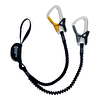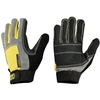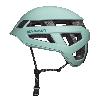Accidents in the Himalaya and helicopter rescues

 1 / 12
1 / 12 arch. Simone Moro
arch. Simone Moro
During the last couple of years things have changed in the Himalaya. We're referring to the number of helicopter rescues of alpinists stranded at altitudes never experimented before. But also, and it's important to underline this immediately, of the creation - in particular in Nepal - of local enterprises which, with the help of specialised western companies such as Air Zermatt, are beginning to play an important role for all those services and works usually carried out by helicopters in the Alps. It's blatant that helicopter rescues in situations at the extreme limit, those found at the high altitudes in the Himalaya, are associated with extremely high risks, higher still than in the Alps. So despite the specific training that pilots and operators undergo, one has to be prepared for accidents to happen, even grave ones. Like the one that took place on 7 November on Ama Dablam (Himalaya, Nepal) which cost the lives of the pilot Sabin Basnyat and the rescue operator Purna Awale, two members of the Nepalese company Fishtailair. While the facts are well-known, it's worth summarising them nevertheless. David Göttler from Germany and Hiraide Kazuya from Japan, two expert Himalayan mountaineers, had left Ama Damblam Advanced Base Camp at 4855m on 4 November with the intention of establishing a new route in alpine style up the North Ridge. After a night at 5877m (C1) and one at 6358m (C2), on 6 November the two alpinists continued via the North Face to reach the North Ridge , via which they reached an altitude of 6450m. The terrible snow conditions made everything extremely dangerous, so much so that continuing proved impossible. At this point Göttler and Kazuya made their decision: they descended via the North Ridge to 6350m where, at 14:00, they set up their Camp 3. Blocked in, at 16:20 they called for a helicopter rescue via satellite telephone. At 9:00am the next morning (7 November) a helicopter piloted by Sabin Basnyat and with the operator Purna Awale on board rescued David Göttler and transported him safely to Chhukung at 4780m. After circa 10-15 minutes the operation was repeated to rescue Kazuya. But when the helicopter was circa 30cm above the Japanese, it suddenly precipitated down the NE gully. This absolute tragedy cost the lives of the two rescuers, while Kazuya was miraculously unhurt and rescued the next day by another Fishtailair helicopter, this time piloted by Sherchan Ashish.
There can be no doubt that Sabin Basnyat and Purna Awale form part of the long list of men (called heroes, usually) who all over the world have lost their lives in an attempt to rescue those in difficulty. Just as its true that this episode, apart from being extraordinary, is in some way emblematic. It is for this reason that we asked Simone Moro to share his thoughts and put it into perspective, comparing what is happening in Nepal with regards to the future of helicopter rescues in that country. As many know, apart from being a Himalayan mountaineer who needs little introduction, Moro has obtained the commercial pilot's license which enables him to fly in Nepal. He is a partner of Fishtailair and together with Sabin Basnyat and Purna Awale, the victims of the accident, has carried out various helicopter rescue operations in the Himalaya.
HELICOPTER RESCUES IN NEPAL AND THE ACCIDENT OF SABIN BASNYAT AND PURNA AWALE
by Simone Moro
We had just spent an entire day talking about it at the International Mountain Summit in Bressanone. We had discussed problems, difficulties, risks, expectations and ideas to support the helicopter rescue in the Himalaya which, thanks to the Nepalese Fishtailair, has begun to operate at altitudes hitherto unheard of. The co-operation between this Nepalese company and Air Zermatt had resulted in the attempt to rescue the unfortunate Tomaz Humar on Langtang Lirung (his body was recovered), and the rescue of Spaniards Oirzabal, Pauner & C at almost 7000m on Annapurna, as well as the Koreans at 6500m on Manaslu and numerous other alpinists stranded on mountains dotted throughout Nepal. In short, carrying out helicopter rescues at progressively higher altitudes was becoming a reality, in conditions where the air and the winds, coupled with pure helicopter mechanics, renders any rescue operations truly extreme.
Human resources (pilots and technicians) weren't missing, seeing that the Nepalese pilots are extremely capable and learn quickly. And neither were the mechanical resources lacking, ie the two AS350 B3 Plus helicopters acquired by Fishtailair which, thanks to the 847hp from a single turbine engine, manage to satisfy the new operational demands at extremely high altitudes. The problems that remain however (apart from the human factor) are the environmental conditions which change from one moment to the next. Wind, temperature, altitude, the specific rescue point are all factors which often condition the final result and determine the true level of risk. In addition, global warming is making not only life on this planet, but also helicopter rescues increasingly difficult. The cold is a precious ally for helicopters as it renders flights more efficient (compared to altitude density) but due to the constant rise in temperatures flight performance tends to become increasingly critical. Flights are carried out early in the morning to find favourable conditions but the zero degree altitude ignores all tactics and goodwill.
All these and other thoughts at the IMS in Bressanone had to be confronted with the news, which stunned and dismayed all, which came directly from Nepal. Our friend and excellent pilot Sabin Basnyat and the rescue operator Purna Awale - which whom I started to work circa a month ago as partner and pilot of Fishtailair - died during an attempt to rescue David Göttler from Germany and Hiraide Kazuya from Japan off Ama Dablam. The first alpinist had been plucked off the North Ridge at 6500m and transported to safety on Chhukung at 4780m. But during the second flight, intended to rescue the Japanese from the top of a cornice he had climbed to render operations possible, a rotor blade struck something similar (cornice/snow mushroom) nearby but slightly higher up on the crest.
The helicopter had been hovering, above the Japanese's head who, during a first attempt, had failed to climb on board. During the successive attempt to get closer the tragedy occurred. The helicopter precipitated disasterously down the NE Face as Hiraide, David and others in the distant village of Chhukung watched aghast. The Japanese remained miraculously unhurt, despite the fact that the helicopter had been hovering just a few centimeters above his head. Suddenly he was alone once again on the Ama Dablam ridge, with the excruciating pain of having watched his rescuers fall to their death.
An agitated and difficult communication phase began immediately between the Japanese, Dave, the authorities and embassies and also Fishtailair. In the meantime Hiraide pitched his tent and prepared to resist on the ridge in a bivvy which could easily transform into his tomb should a rescue not materialise. But the next day the second, and only B3 Plus helicopter belonging to Fishtail, set off for Ama Dablam with the aim of getting Hiraide Kazuya out of trouble. The pilot Sherchan Ashish, despite the emotional involvement due to the loss of Sabin and Purna and the difficult environmental conditions, returned to the crash site and bivvy and, using the same technique, plucked off Kazuya and safely transported him to Lukla.
David and Hiraide weren't inexperienced (I spoke to David Göttler a few days ago), they had just established a new route in alpine style up the North Face and they had reached the North Ridge climbed in 2001 by a British expedition. Sabin and Purna weren't unprepared either and had previously carried out rescues at that altitude and in similar conditions. Both partnerships were carrying out their profession and living out their passion. There's no point writing and saying foolish things about those looking for trouble, or playing around with "ifs" and "buts". As an alpinist and pilot I perfectly understand both the two mountaineers and the two rescuers who died as well as those who, the next day, returned to finish off the business.
Just like me many others reflect and suffer rather than inventing versions and passing sentences. Here in Italy it's normal that, anytime someone hurts themselves, they can just dial a number and be rescued. But in Nepal this luxury doesn't exist and this is only now becoming a real possibility thanks only to people and businessmen who invest money, passion and professionalism for others, knowing full well that the leasing rates for acquiring a helicopter have to be paid, just like the salaries of the flight and ground staff, the insurance, etc. Just to get rid on any doubts, it's worth noting that this rescue service is extended above all to the local population t extremely favourable rates to combat the nigh total lack of personal insurance.
Apart from the local population and the alpinists there is also the extremely numerous group of trekkers and walkers which represent the vast majority of rescue operations. The few helicopters in Nepal are also involved in transporting gear and material to build small hydroelectric dams and bridges, transporting food to remote areas as well as to lodges and mountain huts in the Nepalese valleys, exactly as in many huts across the Alps. Porters are far cheaper and they continue to work without the fear of being replaced by this means of transportation.
Now there is one helicopter less in Nepal but above all there is one less pilot and rescue operator. They had even been to Zermatt twice for specific training on how to rescue injured climbers off mountain faces. Nepal and the mountaineering community have lost two precious and unique guardian angels who must now be remembered and commemorated with the formation of two other professionals like them. This is the aim I have set myself.
To find the economic resources and raise awareness to provide others like Sabin and Purna with all the training necessary to operate in the Himalaya. This resulted from the congress in Bressanone, too. Messner and all the other climbers invited to take part in that historic meeting agreed that local teams of pilots and rescuers must be formed for a quick, economically viable and efficient response. At the moment only Air Zermatt has shown interest and awareness in the Nepalese helicopter world and this must be both recognised and commended. But I would like something to come forward from our part of the Alps, too, because our capabilities and mountain rescue tradition are second-to-none, if only we manage to do something and put a hand on both our heart and wallet.
I for my part have begun by becoming a partner of Fishtailair by paying for all costs personally, flying in Nepal and offering my mountaineering experience and knowledge of the mountains there. It would be truly fantastic if we Italians, who historically have been and still are, keen Himalayan mountaineers, managed to put a hand on our heart and in our wallet to help one of the poorest and most special countries in the world. Dialling the rescue number is an acquired right here, almost something obvious which all-too-often is even abused. Forbidding this service for others in Nepal would be wholly unjust and a self-inflicted injury. I hope that the fundamentalists of helicopters "always and everywhere" will abstain from saying idiotic things before they or some relative need to be rescued, perhaps next to a busy road, a packed stadium or simply on a pleasant walk with the family in the mountains or at the seaside. Common sense is needed both in the sky and on the ground, in the family and in society in general, at work and at school, in Nepal just like in Italy and the rest of the world
I spoke to David Göttler a few days ago for circa an hour about the dynamics of the accident and about what must now be said and done. David kindly gave me all the numbers and details which I have included in this text and which with his permission I have now put at your disposal to be read and analysed, in the hope that this all serves to understand better.
>> The accident report by David Göttler
| Planetmountain | |
| News Simone Moro | |
| News Himalaya | |
| www | |
| www.extremehd.net | |
| simonemoro.blogspot.com | |
| Expo Planetmountain | |
| Expo The North Face | |
| Expo CAMP | |
| Expo La Sportiva | |



 Copia link
Copia link









 See all photos
See all photos






















